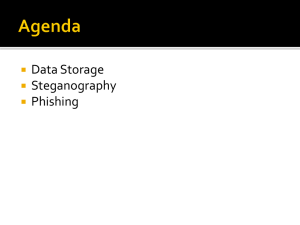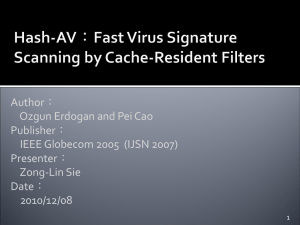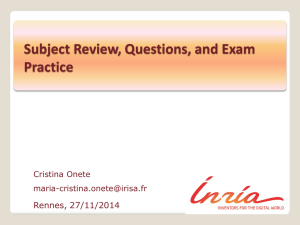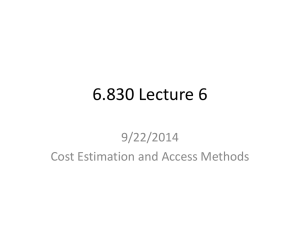CS202 - Fundamentals of Computer Science II
advertisement
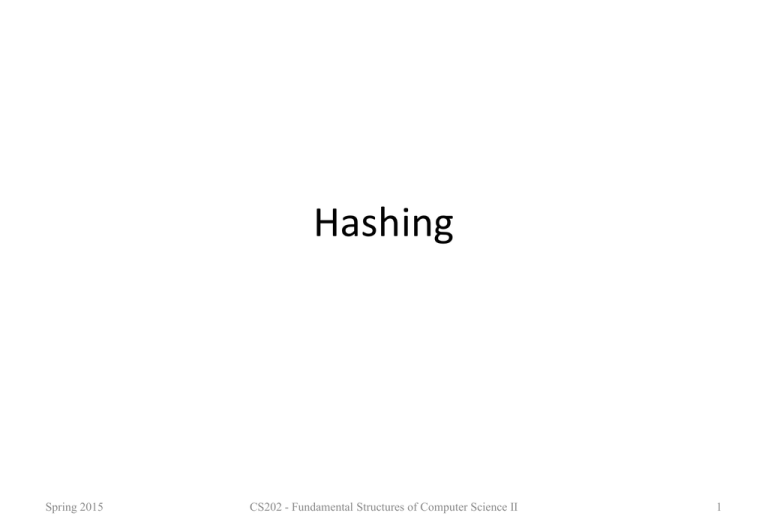
Hashing
Spring 2015
CS202 - Fundamental Structures of Computer Science II
1
Hashing
• Using balanced search trees (2-3, 2-3-4, red-black,
and AVL trees), we implement table operations in
O (logN) time
– retrieval, insertion, and deletion
• Can we find a data structure so that we can
perform these table operations even faster (e.g.,
in O(1) time)?
– Hash Tables
Spring 2015
CS202 - Fundamental Structures of Computer Science II
2
Hash Tables
• In hash tables, we have
– An array (index ranges 0 … n – 1) and
• Each array location is called a bucket
– An address calculator (hash function), which maps a
search key into an array index between 0 … n – 1
Spring 2015
CS202 - Fundamental Structures of Computer Science II
3
Hash Function -- Address Calculator
Hash Function
Hash Table
Spring 2015
CS202 - Fundamental Structures of Computer Science II
4
Hashing
• A hash function tells us where to place an item in
array called a hash table.
– This method is known as hashing.
• Hash function maps a search key into an integer
between 0 and n – 1.
– We can have different hash functions.
– Hash function depends on key type (int, string, ...)
• E.g., h(x) = x mod n, where x is an integer
Spring 2015
CS202 - Fundamental Structures of Computer Science II
5
Collisions
• A perfect hash function maps each search key into a
unique location of the hash table.
– A perfect hash function is possible if we know all search keys
in advance.
– In practice (we do not know all search keys), and thus, a hash
function can map more than one key into the same location.
• Collisions occur when a hash function maps more than
one item into the same array location.
– We have to resolve the collisions using a certain mechanism.
Spring 2015
CS202 - Fundamental Structures of Computer Science II
6
Hash Functions
• We can design different hash functions.
• But a good hash function should
– be easy and fast to compute
– place items uniformly (evenly) throughout the hash table.
• We will consider only integer hash functions
– On a computer, everything is represented with bits.
– They can be converted into integers.
• 1001010101001010000110…. remember?
Spring 2015
CS202 - Fundamental Structures of Computer Science II
7
Everything is an Integer
• If search keys are strings, think of them as integers, and apply
a hash function for integers.
• For example, strings can be encoded using ASCII codes of
characters.
• Consider the string “NOTE”
– ASCII code of N is 4Eh (01001110), O is 4Fh (01001111),
T is 54h(01010100), E is 45h (01000101)
– Concatenate four binary numbers to get a new binary number
01001110010011110101010001000101= 4E4F5445h = 1313821765
Spring 2015
CS202 - Fundamental Structures of Computer Science II
8
How to Design a Hash Function?
• Three possibilities
1. Selecting digits
2. Folding
3. Modular Arithmetic
• Or, their combinations
Hash Function
Spring 2015
CS202 - Fundamental Structures of Computer Science II
9
Hash Table
Hash Functions -- Selecting Digits
• Select certain digits and combine to create the address.
• For example, suppose that we have 11-digit Turkish
nationality ID’s
– Define a hash function that selects the 2nd and 5th most
significant digits
h(033475678) = 37
h(023455678) = 25
– Define the table size as 100
• Is this a good hash function?
– No, since it does not place items uniformly.
Spring 2015
CS202 - Fundamental Structures of Computer Science II
10
Hash Functions -- Folding
• Folding – selecting all digits and adding them.
• For example, suppose previous nine-digit numbers
– Define a hash function that selects all digits and adds them
h(033475678) = 0 + 3 + 3 + 4 + 7 + 5 + 6 + 7 + 8 = 43
h(023455678) = 0 + 2 + 3 + 4 + 5 + 5 + 6 + 7 + 8 = 40
– Define the table size as 82
• We can select a group of digits and add the digits in this
group as well.
Spring 2015
CS202 - Fundamental Structures of Computer Science II
11
Hash Functions -- Modular Arithmetic
• Modular arithmetic – provides a simple and effective
hash function.
h(x) = x mod tableSize
• The table size should be a prime number.
– Why? Think about it.
• We will use modular arithmetic as our hash function in
the rest of our discussions.
Spring 2015
CS202 - Fundamental Structures of Computer Science II
12
Why Primes?
• Assume you hash the following with x mod 8:
– 64, 100, 128, 200, 300, 400, 500
0
64
128
200
400
1
2
3
4
100
300
500
5
6
7
Spring 2015
CS202 - Fundamental Structures of Computer Science II
13
Why Primes?
• Now try it with x mod 7
– 64, 100, 128, 200, 300, 400, 500
0
1
64 128
2
100
3
500
4
200
400
5
6
Spring 2015
300
CS202 - Fundamental Structures of Computer Science II
14
Rationale
• If we are adding numbers a1, a2, a3 … a4 to a table of size m
– All values will be hashed into multiples of
gcd(a1, a2, a3 … a4 ,m)
– For example, if we are adding 64, 100, 128, 200, 300, 400, 500 to
a table of size 8, all values will be hashed to 0 or 4
gcd(64,100,128,200,300,400,500, 8) = 4
– When m is a prime gcd(a1, a2, a3 … a4 ,m) = 1, all values will be
hashed to anywhere
gcd(64,100,128,200,300,400,500,7) = 1
unless gcd(a1, a2, a3 … a4 ) = m, which is rare.
Spring 2015
CS202 - Fundamental Structures of Computer Science II
15
Collision Resolution
• Collision resolution – two general approaches
– Open Addressing
Each entry holds one item
– Chaining
Each entry can hold more than item
(Buckets – hold certain number of items)
Spring 2015
CS202 - Fundamental Structures of Computer Science II
Table size is 101
16
Open Addressing
• Open addressing – probes for some other empty
location when a collision occurs.
• Probe sequence: sequence of examined locations.
Different open-addressing schemes:
– Linear Probing
– Quadratic Probing
– Double Hashing
Spring 2015
CS202 - Fundamental Structures of Computer Science II
17
Open Addressing -- Linear Probing
• linear probing: search table sequentially starting
from the original hash location.
– Check next location, if location is occupied.
– Wrap around from last to first table location
Spring 2015
CS202 - Fundamental Structures of Computer Science II
18
Linear Probing -- Example
• Example:
– Table Size is 11 (0..10)
– Hash Function: h(x) = x mod 11
– Insert keys: 20, 30, 2, 13, 25, 24, 10, 9
•
•
•
•
•
•
•
•
Spring 2015
20 mod 11 = 9
30 mod 11 = 8
2 mod 11 = 2
13 mod 11 = 2 2+1=3
25 mod 11 = 3 3+1=4
24 mod 11 = 2 2+1, 2+2, 2+3=5
10 mod 11 = 10
9 mod 11 = 9 9+1, 9+2 mod 11 =0
CS202 - Fundamental Structures of Computer Science II
0
9
1
2
2
3
13
4
25
5
24
6
7
8
30
9
20
10
10
19
Linear Probing -- Clustering Problem
• One of the problems with linear probing is that table items
tend to cluster together in the hash table.
– i.e. table contains groups of consecutively occupied locations.
• This phenomenon is called primary clustering.
– Clusters can get close to one another, and merge into a larger
cluster.
– Thus, the one part of the table might be quite dense, even though
another part has relatively few items.
– Primary clustering causes long probe searches, and therefore,
decreases the overall efficiency.
Spring 2015
CS202 - Fundamental Structures of Computer Science II
20
Open Addressing -- Quadratic Probing
• Quadratic probing: almost eliminates clustering problem
• Approach:
– Start from the original hash location i
– If location is occupied, check locations i+12, i+22,
i+32, i+42 ...
– Wrap around table, if necessary.
Spring 2015
CS202 - Fundamental Structures of Computer Science II
21
Quadratic Probing -- Example
• Example:
– Table Size is 11 (0..10)
– Hash Function: h(x) = x mod 11
– Insert keys: 20, 30, 2, 13, 25, 24, 10, 9
•
•
•
•
•
•
•
•
Spring 2015
20 mod 11 = 9
30 mod 11 = 8
2 mod 11 = 2
13 mod 11 = 2 2+12=3
25 mod 11 = 3 3+12=4
24 mod 11 = 2 2+12, 2+22=6
10 mod 11 = 10
9 mod 11 = 9 9+12, 9+22 mod 11,
9+32 mod 11 =7
CS202 - Fundamental Structures of Computer Science II
0
1
2
2
3
13
4
25
5
6
24
7
9
8
30
9
20
10
10
22
Open Addressing -- Double Hashing
• Double hashing also reduces clustering.
• Idea: increment using a second hash function h2. Should
satisfy:
h2(key) 0
h2h1
• Probes following locations until it finds an unoccupied place
h1(key)
h1(key) + h2(key)
h1(key) + 2*h2(key),
...
Spring 2015
CS202 - Fundamental Structures of Computer Science II
23
Double Hashing -- Example
• Example:
– Table Size is 11 (0..10)
– Hash Function:
h1(x) = x mod 11
h2(x) = 7 – (x mod 7)
– Insert keys: 58, 14, 91
• 58 mod 11 = 3
• 14 mod 11 = 3 3+7=10
• 91 mod 11 = 3 3+7, 3+2*7 mod 11=6
0
1
2
3
58
4
5
6
91
7
8
9
10
Spring 2015
CS202 - Fundamental Structures of Computer Science II
14
24
Open Addressing -- Retrieval & Deletion
• Retrieving an item with a given key:
– (same as insertion): probe the locations until we find the desired
item or we reach to an empty location.
• Deletions in open addressing cause complications
– We CANNOT simply delete an item from the hash table because
this new empty (a deleted) location causes to stop prematurely
(incorrectly) indicating a failure during a retrieval.
– Solution: We have to have three kinds of locations in a hash
table: Occupied, Empty, Deleted.
– A deleted location will be treated as an occupied location during
retrieval.
Spring 2015
CS202 - Fundamental Structures of Computer Science II
25
Separate Chaining
• Another way to resolve collisions is to change the structure
of the hash table.
– In open-addressing, each location holds only one item.
• Idea 1: each location is itself an array called bucket
– Store items that are hashed into same location in this array.
– Problem: What will be the size of the bucket?
• Idea 2: each location is itself a linked list. Known as
separate-chaining.
– Each entry (of the hash table) is a pointer to a linked list (the
chain) of the items that the hash function has mapped into that
location.
Spring 2015
CS202 - Fundamental Structures of Computer Science II
26
Separate Chaining
Spring 2015
CS202 - Fundamental Structures of Computer Science II
27
Hashing Analysis
Spring 2015
CS202 - Fundamental Structures of Computer Science II
28
Hashing -- Analysis
• An analysis of the average-case efficiency of hashing involves
the load factor :
= (current number of items) / tableSize
• measures how full a hash table is.
– Hash table should not be too loaded if we want to get better
performance from hashing.
• In average case analyses, we assume that the hash function
uniformly distributes keys in the hash table.
• Unsuccessful searches generally require more time than
successful searches.
Spring 2015
CS202 - Fundamental Structures of Computer Science II
29
Separate Chaining -- Analysis
• Separate Chaining – approximate average number of
comparisons (probes) that a search requires :
1
for a successful search
2
for an unsuccessful search
• It is the most efficient collision resolution scheme.
• But it requires more storage (needs storage for pointers).
• It easily performs the deletion operation. Deletion is more
difficult in open-addressing.
Spring 2015
CS202 - Fundamental Structures of Computer Science II
30
Linear Probing -- Analysis
• Linear Probing – approximate average number of
comparisons (probes) that a search requires :
1
1
1
2 1
for a successful search
1
1
1
2 (1 ) 2
for an unsuccessful search
• Insert and search cost depend on
length of cluster.
• Average length of cluster = = N / M.
• Worst case: all keys hash to the same cluster.
Spring 2015
CS202 - Fundamental Structures of Computer Science II
31
Linear Probing -- Analysis
• Linear Probing – approximate average number of
comparisons (probes) that a search requires :
1
1
1
2 1
for a successful search
1
1
1
2 (1 ) 2
for an unsuccessful search
• As load factor increases, number of collisions increases,
causing increased search times.
• To maintain efficiency, it is important to prevent the hash
table from filling up.
Spring 2015
CS202 - Fundamental Structures of Computer Science II
32
Linear Probing -- Analysis
Example: Find the average number of probes for a successful
search and an unsuccessful search for this hash table? Use the
following hash function: h(x) = x mod 11
0
9
1
Successful Search: Try 20, 30, 2, 13, 25, 24, 10, 9
20: 9
30: 8
2: 2
13: 2,3
25: 3, 4
24: 2, 3, 4, 5 10: 10
9: 9, 10, 0
Avg. no of probes = (1+1+1+2+2+4+1+3)/8 = 1.9
2
2
3
13
4
25
5
24
Unsuccessful Search: Try 0, 1, 35, 3, 4, 5, 6, 7, 8, 9, 32
0: 0,1
1:1
35: 2, 3, 4, 5, 6
3: 3, 4, 5, 6
4: 4, 5, 6
5: 5, 6
6:6
7: 7
8: 8, 9, 10, 0, 1
9: 9, 10, 0, 13 2: 10,0,1
Avg. no of probes =(2+1+5+4+3+2+1+1+5+4+3)/11 = 2.8
6
Spring 2015
CS202 - Fundamental Structures of Computer Science II
7
8
30
9
20
10
10
33
Quadratic Probing & Double Hashing -- Analysis
• The approximate average number of comparisons (probes)
that a search requires is given as follows:
1 log e (1 )
1
(log e 1 )
for a successful search
1
1
for an unsuccessful search
• On average, both methods require fewer comparisons than
linear probing.
Spring 2015
CS202 - Fundamental Structures of Computer Science II
34
The relative efficiency of
four collision-resolution methods
Spring 2015
CS202 - Fundamental Structures of Computer Science II
35
What Constitutes a Good Hash Function
• A hash function should be easy and fast to compute.
• A hash function should scatter the data evenly
throughout the hash table.
– How well does the hash function scatter random data?
– How well does the hash function scatter non-random data?
• Two general principles :
1. The hash function should use entire key in the calculation.
2. If a hash function uses modulo arithmetic, the table size
should be prime.
Spring 2015
CS202 - Fundamental Structures of Computer Science II
36
Example: Hash Functions for Strings
Spring 2015
CS202 - Fundamental Structures of Computer Science II
37
Hash Function 1
• Add up the ASCII values of all characters of the key.
int hash(const string &key, int tableSize)
{
int hasVal = 0;
for (int i = 0; i < key.length(); i++)
hashVal += key[i];
return hashVal % tableSize;
}
• Simple to implement and fast.
• However, if the table size is large, the function does not
distribute the keys well.
• e.g. Table size =10000, key length <= 8, the hash function can assume
values only between 0 and 1016
Spring 2015
CS202 - Fundamental Structures of Computer Science II
38
Hash Function 2
• Examine only the first 3 characters of the key.
int hash (const string &key, int tableSize)
{
return (key[0]+27 * key[1] + 729*key[2]) % tableSize;
}
• In theory, 26 * 26 * 26 = 17576 different words can be generated.
However, English is not random, only 2851 different
combinations are possible.
• Thus, this function although easily computable, is also not
appropriate if the hash table is reasonably large.
Spring 2015
CS202 - Fundamental Structures of Computer Science II
39
Hash Function 3
hash( key )
KeySize1
i
Key
[
KeySize
i
1
]
37
i 0
int hash (const string &key, int tableSize)
{
int hashVal = 0;
for (int i = 0; i < key.length(); i++)
hashVal = 37 * hashVal + key[i];
hashVal %=tableSize;
if (hashVal < 0)
/* in case overflows occurs */
hashVal += tableSize;
return hashVal;
};
Spring 2015
CS202 - Fundamental Structures of Computer Science II
40
Hash function for strings:
key[i]
98 108 105
key a
0
l
i
1 2
i
KeySize = 3;
hash(“ali”) = (105 * 1 + 108*37 + 98*372) % 10,007 = 8172
“ali”
0
1
2
hash
function
……
ali
8172
……
10,006 (TableSize)
Spring 2015
CS202 - Fundamental Structures of Computer Science II
41
Hash Table versus Search Trees
• In most of the operations, the hash table performs
better than search trees.
• However, traversing the data in the hash table in a
sorted order is very difficult.
– For similar operations, the hash table will not be good
choice (e.g., finding all the items in a certain range).
Spring 2015
CS202 - Fundamental Structures of Computer Science II
42
Performance
• With either chaining or open addressing:
–
–
–
–
Search - O(1) expected, O(n) worst case
Insert - O(1) expected, O(n) worst case
Delete - O(1) expected, O(n) worst case
Min, Max and Predecessor, Successor - O(n+m) expected
and worst case
• Pragmatically, a hash table is often the best data
structure to maintain a dictionary/table. However, the
worst-case time is unpredictable.
• The best worst-case bounds come from balanced
binary trees.
Spring 2015
CS202 - Fundamental Structures of Computer Science II
43
Other applications of hash tables
•
•
•
•
•
•
•
To implement Table ADT, Dictionary ADT
Compilers
Spelling checkers
Games
Substring Pattern Matching
Searching
Document comparison
Spring 2015
CS202 - Fundamental Structures of Computer Science II
44
Applications of Hashing
• Compilers use hash tables to implement the
symbol table (a data structure to keep track of
declared variables).
• Game programs use hash tables to keep track of
positions it has encountered (transposition table)
• Online spelling checkers.
Spring 2015
CS202 - Fundamental Structures of Computer Science II
45
Substring Pattern Matching
• Input: A text string t and a pattern string p.
• Problem: Does t contain the pattern p as a substring, and
if so where?
• e.g: Is Bilkent in the news?
• Brute Force: search for the presence of pattern string p in
text t overlays the pattern string at every position in the
text. O(mn)
(m: size of pattern, n: size of text)
• Via Hashing: compute a given hash function on both the
pattern string p and the m-character substring starting
from the ith position of t. O(n)
Spring 2015
CS202 - Fundamental Structures of Computer Science II
46
Slide by Steven Skiena
Hashing, Hashing, and Hashing
• Udi Manber says that the three most important
algorithms at Yahoo are hashing, hashing, and
hashing.
• Hashing has a variety of clever applications
beyond just speeding up search, by giving you a
short but distinctive representation of a larger
document.
Spring 2015
CS202 - Fundamental Structures of Computer Science II
47
Slide by Steven Skiena
Document Comparison
• Is this new document different from the rest in a
large database? – Hash the new document, and
compare it to the hash codes of database.
• How can I convince you that a file isn’t changed? –
Check if the cryptographic hash code of the file
you give me today is the same as that of the
original. Any changes to the file will change the
hash code.
Spring 2015
CS202 - Fundamental Structures of Computer Science II
48
Slide by Steven Skiena



